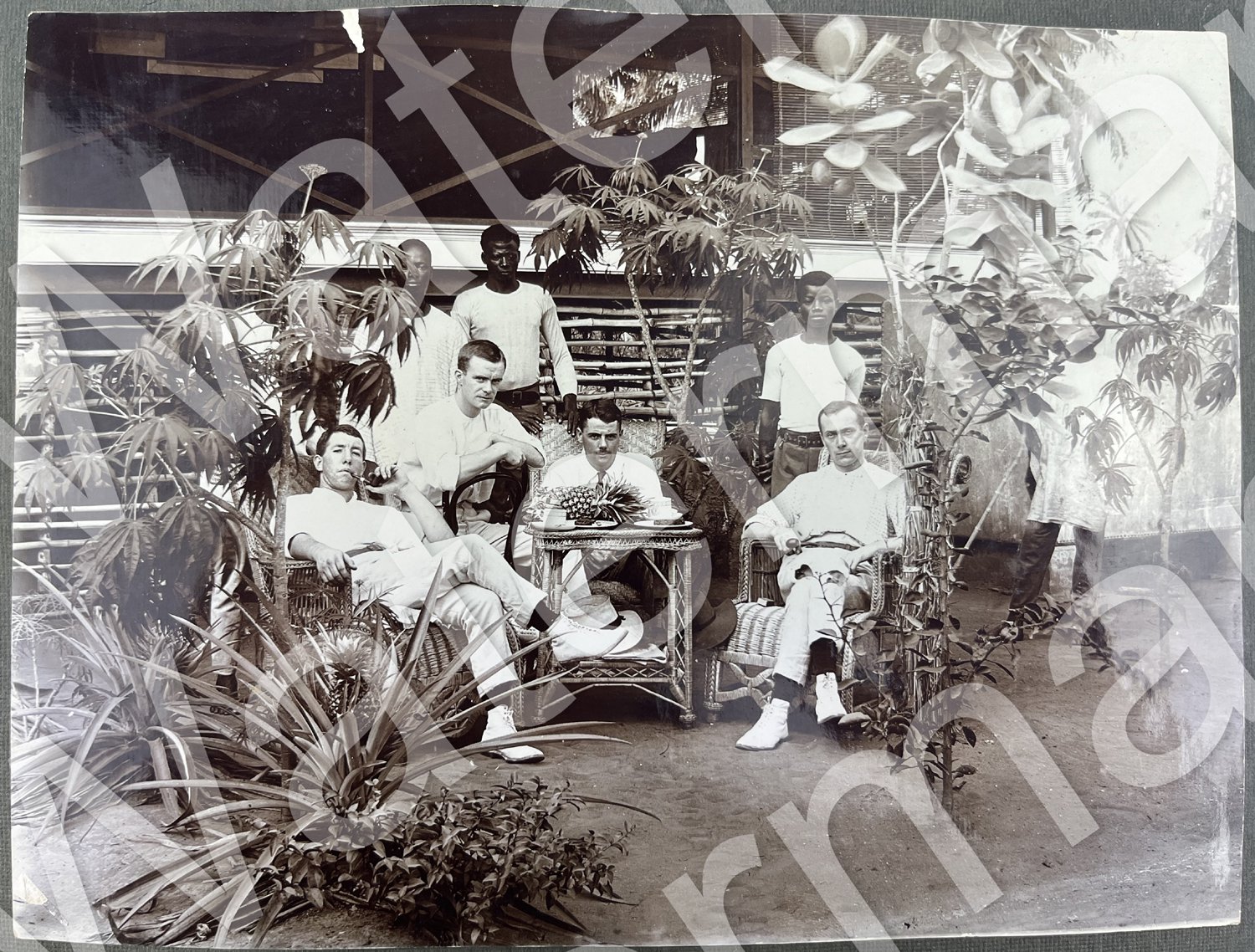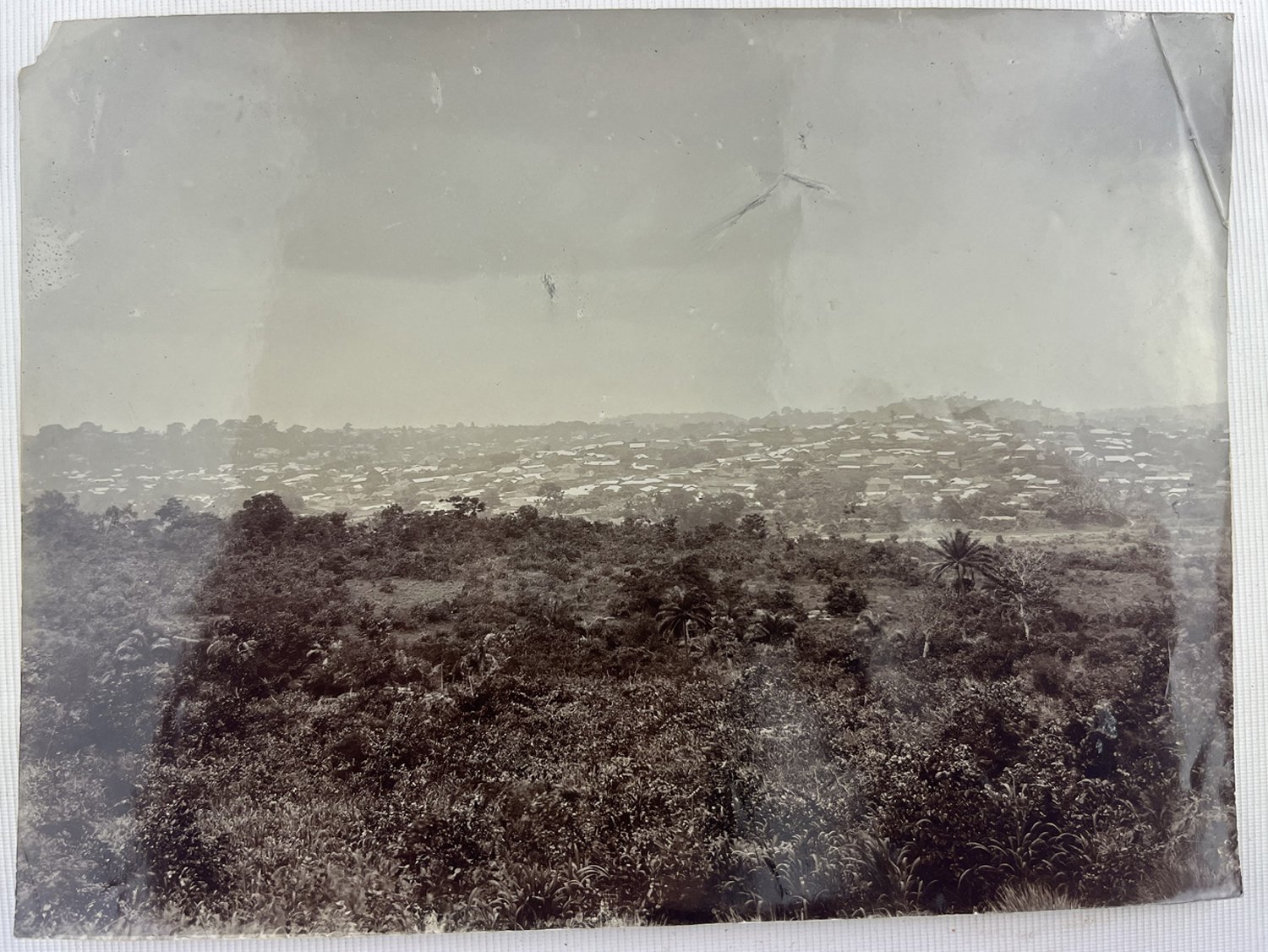Circa 1905 photograph album and loose photographs.
The photographs appear to have been taken in Nigeria by Europeans, probably British, living and working in West Africa, possibly for the British Cotton Growing Association. The following few photographs appear to suggest this idea:
Postcard backed photo showing bales in front of a building with 'BCGA' above the entrance.
A cut-down postcard backed photo of stacked sacks, one marked 'B.C.G.A.' to front.
Photograph of a moustachioed gentleman with 'Mr. Worsley' penciled to the rear. This could be the Mr. Worsley who was Chairman of the B.C.G.A. in West Africa at the time.
There are 67 photographs in total, a mixture of mounted and loose matt finish and glossy silver gelatin prints. Nine photos are postcard backed, as was the fashion of the day. All photos appear to depict African subjects except for the first photo in the album, which appears to be a view of Las Palmas or similar, with an African railway scene to reverse.
The album contains 43 of the photographs with sizes ranging from about an inch squared to about 8 x 6 inches.
Sizes:
14 roughly 8 x 6 inches.
5 roughly 1 x 1 inch.
14 roughly 3 x 4 inches.
8 x roughly 6 x 4 inch.
2 roughly 6 x 3 inches.
As well as the album, there are 24 loose photographs with sizes ranging from about 2.5 x 4 inches (cut-down pc) to about 6 x 8 inches (the 7 distant, almost aerial views of villages/towns.)
---
There are intimate views within villages and remote, almost aerial views of towns. There are photos of houses, civic buildings and commercial properties. There is the harbour, the railroad, two weddings and a horserace. There are many examples of portraiture, including Europeans 'dressed' as Africans and Africans dressed as Europeans. And, if I'm not reading too much into them, many of the sitters, European and African, appear to wear uneasy, suspicious and even resentful looking expressions. There are several large excellent photographs of Emirs and their retinue, including the Emir of Kano, and possibly the Emir of Katsina, Muhammad Dikko. There are also two sad photos of a dead hippopotamus and a lion.
Helpfully, half a dozen photos have identifying inscriptions penciled to the rear, two of which are only visible because the corners have lifted. Other sitters and locations will no doubt be identified by those more familiar with Africa and it's history.
Inscribed photos include:
The above mentioned 'Mr. Worsley' photograph.
'Emir Kano'' to rear of a 8 x 6 photo of the Emir and party.
'Emir of Boram' [or similar] to rear of an 8 x 6 photo of the Emir and party.
'Chief advisor to Emir of Katsina N. Nigeria' to rear of a roughly 3 x 4 inch photograph of a man on horseback. The same man can also be seen in at least one other photograph sitting close to the then Emir of Katsina, Muhammad Dikko, surrounded by his entourage.Apologies for the use of watermarks on some of the photos, but this is an attempt to protect the uniqueness of the images for the eventual new owner.
---
Condition (please also see images):
The album is simply bound using a string tie, so the photos can be removed and put back without damage.
Some wear, marking and discolouration to album covers.
Album photos are clean and undamaged except for a few light creases & bent corners and a missing corner to two 8 x 6 inch photos.
Most of the loose photographs have light edge wear except for the 7 'distant views', which have creased corners (now strengthened with archive tape) and four missing corners. Four 'midget' postcards have been trimmed and another has damage to the rear where removed from an album.
A rare collection with many unique & historically significant images.
---
The Kano Emirate was a Muslim state in Northern Nigeria formed in 1349 during the reign of Sarkin Kano Ali Yaji when Wangarawa brought Islam into Kano and Sarki Ali made Islam the State religion. Sarki Muhammadu Rumfa (1463-1499) consolidated the achievement of Sarki Ali Yaji when he became Sarki.
Rumfa's reign is believed to be the greatest in terms of both economic and intellectual development till date. He helped introduce Ajami (a Hausa language writing using Arabic texts) which continued until 1903 with the beginning of British colonialism after they deposed a fulani Sarki named Ali Babba.
It was Sarki Muhammadu Rumfa who constructed the current Mosque adjacent to Emir's palace which is popularly known as Masallacin Sarki (i.e. Sarki's mosque) and he is acknowledged to be the one who constructed the present Emir's palace (Gidan Rumfa) and occupied it leaving the former palace to be converted as Museum (Gidan Makama Museum). During and after the British colonial period, the powers of the emirate were steadily reduced. The emirate is preserved and integrated into modern Nigeria as the Kano Emirate Council.
The Hausa Kingdom of Kano was based on an ancient settlement of Dala Hill. While small chiefdoms were previously present in the area, according to the Kano Chronicle, Bagauda, a grandson of the mythical hero Bayajidda, became the first king of Kano in 999, reigning until 1063. Muhammad Rumfa ascended to the throne in 1463 and reigned until 1499. During his reign he reformed the city, expanded the Sahelian Gidan Rumfa (Emir's Palace), and played a role in the further Islamization of the city as he urged prominent residents to convert. The Hausa state remained independent until the Fulani conquest of 1805.
At the beginning of the 19th century, Fulani leader Usman dan Fodio led a jihad affecting much of northern Nigeria, leading to the emergence of the Sokoto Caliphate. Kano became the largest and most prosperous province of the empire.
From 1893 until 1895, two rival claimants for the throne fought a civil war. With the help of royal slaves, Yusufu was victorious over Tukur and claimed the title of emir.
The British pacification campaign termed Kano-Sokoto Expedition set off from Zaria at the end of January 1903 under the command of Colonel Morland. British officers and N.C.O.s and 800 African rank and file. Apart from a company of mounted infantry and a few gunners, the whole force consisted of infantry. They were supported, however, by four 75-mm. mountain guns, which could if necessary be dismantled and transported by porters, and by six machine guns.
After sporadic fighting outside the walls of the fort, the British managed to penetrate the defensive parameters of the capital. Kano was mostly left defenseless at the time, the Emir, Aliyu Babba was away with its large contingent Cavalry for the Autumn Campaign at Sokoto. News of the British capture of Kano in February 1903 sent the Cavalry in a long march to retake the city.
After successfully defeating the British in three encounters, on 27 February 1903, the Grand Vizier of Kano; Ahmadu Mai Shahada and much of the Kano Cavalry was ambushed at Katarkwashi. The death of the Vizier and subsequent capture and exile to Lokoja of the 7th emir of Kano; Aliyu Babba spelled the formative end of the Kano Emirate. The British made Kano an important administrative centre and kept most of the Emirates institutions in the form of the Kano Emirate Council subject to the British crown in a newly formed state called Northern Nigeria.
---
Katsina. Surrounded by city wall 21 kilometres in length, Katsina is believed to have been founded circa 1100. In pre-Islamic times, Katsina's semi-divine ruler was known as the Sarki, who faced a summary death-sentence if found to be ruling incompetently. From the 17th to the 18th century, Katsina was the commercial heart of Hausaland and became the largest of the seven Hausa city-states. Katsina was conquered by the Fulani during the Fulani War in 1807.
During sub-Saharan trade, the city of Katsina was known to be one of the most vibrant and strong commercial centres, and was believed to be the strongest with the Hausa kingdoms in terms of commerce, trade and craft. The German explorer Friedrich Hornemann reached Katsina, the first Westerner to do so, at the beginning of the 19th century.
The Katsina Royal Palace known as 'Gidan Korau' is a huge complex located in the centre of the ancient city. It is a symbol of culture, history and traditions of 'Katsinawa'. According to historical account, it was built in 1348 CE by Muhammadu Korau, who is believed to have been the first Muslim King of Katsina.
The city of Katsina is also home to an 18th-century mosque featuring the Gobarau Minaret, a 15-metre (50 ft) tower made from mud and palm branches.
In 1903, the Emir, Abubakar dan Ibrahim, accepted British rule, which continued until Nigerian independence from Britain in 1960.
---
The British Cotton Growing Association (BCGA) was an organisation formed in 1902 from the various bodies connected with the Lancashire cotton industry which aimed to reduce that industry's dependence on supplies of raw cotton from the United States by promoting the development of cotton growing in the British Empire.
The BCGA saw West Africa as a suitable area for commercial cotton growing, particularly in Nigeria. Cotton, particularly in Northern Nigeria, wasa crop long before the colonial period. The BCGA made an agreement with the Nigerian Government in 1904 to establish model farms and a research station, build ginneries and provide suitable seeds and experts to improve the quality and quantity of the crop.
Initially, yields were small and transport, except were farms were near major rivers or railways, was difficult. Cotton growing was not popular in areas where cocoa, oil palms or peanuts were grown and, in 1910 the Association's research station was closed, so by 1914 the future for cotton looked uncertain. In the Kano region, the Association's was disappointed because the local cotton industry paid as much or more to local farmers as it did, until the railway arrived there in 1912 and cut transport costs.
From 1921, the British Government became increasingly dissatisfied with the BCGA's anomalous position as a non-state organisation and, in 1927, a governmental agency, the Empire Cotton Growing Corporation, took over most of the BCGA's work although the Association continued to operate as a trade representational body.






















































As it is sometimes difficult to properly judge the look and condition of an item from the description and photos alone, please feel free to bid knowing that you can return the item post free if you are not entirely pleased with your purchase.- Please do not hesitate to contact me should you have any questions.
Combined shipping available at cost.
Welsh Bridge Books & Collectables is a bricks and mortar shop located alongside the River Severn at Shrewsbury, in a beautiful 16th Century building housing three floors of interesting and eclectic books and collectables for sale. If you're in Shropshire please pop by and say hello! Thank you.